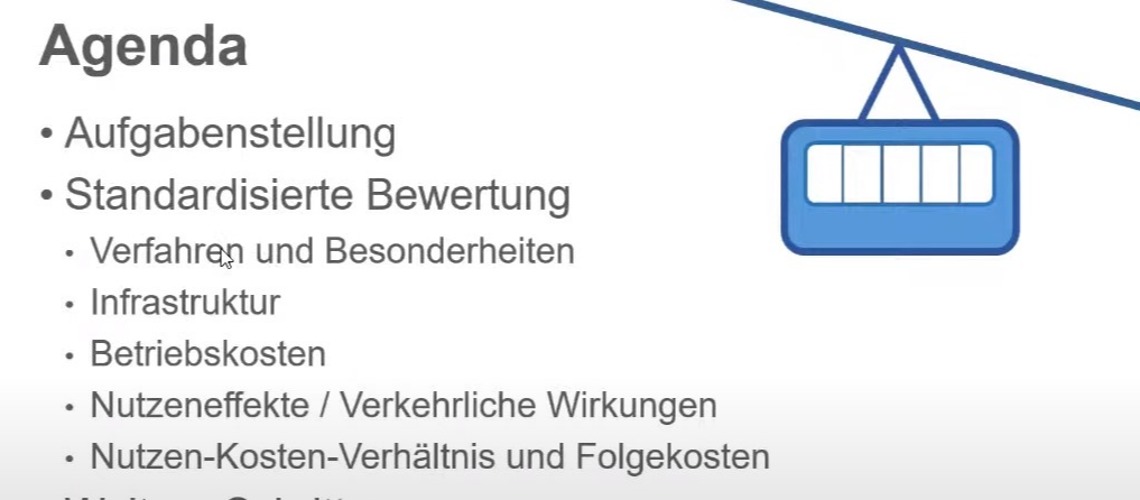Positive Assessments Of Proposed Bonn Cable Car

A cable car in Bonn is an economically sensible project to expand the public transport infrastructure. Bonn could thus take on a pioneering role in Germany, because for the first time a cable car will be integrated into an urban bus and train network and thus into the tariff structure.
The preliminary result of the legally prescribed standardized assessment agreed with the federal and state governments of North Rhine-Westphalia shows that the benefits clearly outweigh the costs (benefit-cost ratio of 1.6). The federal city of Bonn presented this to the public on Monday, November 8th, 2021.
“The cable car would be a major milestone in the direction of sustainable mobility for Bonn. We want to relieve the roads and protect the climate - and for that we need attractive local public transport. The cable car can become an innovative part of our local transport network, ”emphasizes Mayor Katja Dörner. “It would be an important and attractive east-west axis over the Rhine up to the Venusberg. It connects important destinations such as the university clinic, the federal district with the Post Tower and Telekom, among others, and the Beuel district on the right bank of the Rhine with trams, trams and trains. "
"Together with the light rail projects registered for the state's public transport requirement plan, the cable car is one of the infrastructure measures that are extremely important for the further development of the Bonn route network and are urgently needed to significantly strengthen the offer and the alternatives to car traffic," says Bonn's City Planning Officer Helmut Wiesner.
The city administration proposes to the political bodies and the council of the city of Bonn for its meeting on December 9th, 2021, among other things, to take note of the result of the preliminary standardized assessment of the Bonn cable car, to commission the administration to implement the project for the currently valid public transport - Register the requirements plan and have a communication and participation concept drawn up.
The cable car is to run from the future S-Bahn stop Schießbergweg (Limperich / Küdinghoven / Ramersdorf) in the Beuel district on the right bank of the Rhine to the university clinic on the Venusberg on the left bank of the Rhine. As far as possible, the route is based on the existing streets. It is almost 4.3 kilometers in length, is expected to include 34 pillars and will have a total of five stations: Schießbergweg, Rheinaue, UN Campus, Loki-Schmidt-Platz (formerly Hindenburgplatz) and Uniklinikum-West.
This route is the so-called preferred variant of the feasibility study presented to the public in 2017 with the participation of citizens and is the basis for the standardized assessment that has now been developed.
Almost 15,000 passengers would use the cable car every day, and around 12 million car kilometers per year could be avoided.
Standardized evaluation
Investment projects in local public transport (ÖPNV) have to be evaluated due to their macroeconomic and societal importance, both from an economic point of view and taking into account the advantages and disadvantages for passengers as well as the effects on the general public. The basis for the coordination with the state of North Rhine-Westphalia, the federal government (BmVI) and local transport Rhineland (NVR) formed the "procedural instructions for the standardized assessment of investment in transport routes in local public transport (Version 2016)".
The work by an expert office commissioned by the city of Bonn began at the end of 2018 and was successfully completed with a preliminary result in October 2021.
The standardized assessment includes a cost-benefit analysis in order to be able to assess the macroeconomic advantages, and a follow-up cost calculation that clarifies all relevant income and expenses from a business point of view. A project is considered to make economic sense if the total benefit exceeds the costs or the benefit-cost ratio (NAB) is greater than 1. Based on the currently available cost estimate of 66 million euros (net), the benefit-cost ratio is 1.6. In accordance with the procedural instructions, a 30 percent increase in costs compared to the current cost estimate was taken into account due to the project's readiness for planning.
A follow-up cost calculation is part of a standardized assessment. It shows the business side and thus an estimate of the expected annual costs of the project for a possible operator (Stadtwerke Bonn). The financial effects are determined here for a period of up to 30 years. This would result in annual expenses of EUR 800,000 in the short term, EUR 1.1 million in the medium term and EUR 2.1 million in the long term.
Breakdown of costs
The infrastructure costs were determined on the basis of the price level in 2019, separated into ropeway technology, civil engineering / structural engineering and other equipment. The total costs of 66 million euros include: ropeway technology, civil engineering and building construction with foundations, access infrastructure and ropeway buildings as well as planning costs. Costs for the cabins, garages and the surveillance rooms are also included.
Most of the investments can be funded through the Municipal Transport Financing Act (GVFG). The city would have an approximate own contribution of eleven million euros.














